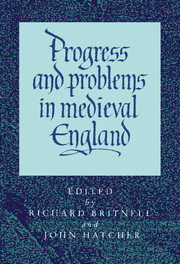Book contents
- Frontmatter
- Contents
- List of figures
- List of maps
- List of tables
- List of contributors
- Edward Miller: an appreciation
- List of abbreviations
- 1 Economic development in the early twelfth century
- 2 Lothian and beyond: the economy of the ‘English empire’ of David I
- 3 Boroughs, markets and trade in northern England, 1000–1216
- 4 Peasant deer poachers in the medieval forest
- 5 The growth of London in the medieval English economy
- 6 The bankruptcy of the Scali of Florence in England, 1326–1328
- 7 The English export trade in cloth in the fourteenth century
- 8 A medieval tax haven: Berwick upon Tweed and the English crown: 1333–1461
- 9 Taxation and communities in late medieval England
- 10 Peasants and the collapse of the manorial economy on some Ramsey Abbey estates
- 11 The famuli in the later Middle Ages
- 12 The great slump of the mid-fifteenth century
- 13 Lorenzo de' Medici's London branch
- 14 The trade of late medieval Chester, 1500–1550
- Bibliography of Edward Miller's published works
6 - The bankruptcy of the Scali of Florence in England, 1326–1328
Published online by Cambridge University Press: 05 June 2012
- Frontmatter
- Contents
- List of figures
- List of maps
- List of tables
- List of contributors
- Edward Miller: an appreciation
- List of abbreviations
- 1 Economic development in the early twelfth century
- 2 Lothian and beyond: the economy of the ‘English empire’ of David I
- 3 Boroughs, markets and trade in northern England, 1000–1216
- 4 Peasant deer poachers in the medieval forest
- 5 The growth of London in the medieval English economy
- 6 The bankruptcy of the Scali of Florence in England, 1326–1328
- 7 The English export trade in cloth in the fourteenth century
- 8 A medieval tax haven: Berwick upon Tweed and the English crown: 1333–1461
- 9 Taxation and communities in late medieval England
- 10 Peasants and the collapse of the manorial economy on some Ramsey Abbey estates
- 11 The famuli in the later Middle Ages
- 12 The great slump of the mid-fifteenth century
- 13 Lorenzo de' Medici's London branch
- 14 The trade of late medieval Chester, 1500–1550
- Bibliography of Edward Miller's published works
Summary
A fourteenth-century Italian merchant in financial difficulties considered a deliberate, sudden bankruptcy as one of the possible solutions to his problems. The purpose of such a move would be to conceal as large a proportion of his assets as was practicable and to ensure for himself a not unprosperous future. There was always a risk of surprising reactions from the victims and political complications could add to the perils of the unscrupulous bankrupt. The public authorities had naturally to intervene and to impose some sort of orderly liquidation of business breakdowns, which might otherwise escalate and spread widespread ruin. All these features can be illustrated from the story of the English branches of the Scali. Their bankruptcy, and that of the Pulci and Rembertini some twenty years earlier, involved the interventions of the royal council and the chancery. The records produced by the resultant official proceedings throw interesting light on an early stage of international banking in western Europe, before the evolution of more uniform types of business documents and of standardised methods of attesting financial liabilities.
The ruthless unscrupulousness of these bankruptcies is well illustrated by what the Frescobaldi of Florence tried to do in Gascony in 1311. The outlines of this story are well known. However, none of the existing accounts spell out all the details. The Frescobaldi were under dire pressure. Their position as the principal bankers of King Edward II had exposed them to relentless hostility of Edward's political opponents, the Lords Ordainers, who were trying to cripple him financially by ruining his chief financiers.
- Type
- Chapter
- Information
- Progress and Problems in Medieval EnglandEssays in Honour of Edward Miller, pp. 107 - 120Publisher: Cambridge University PressPrint publication year: 1996

